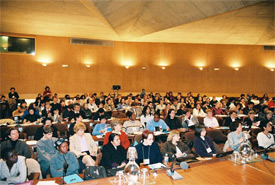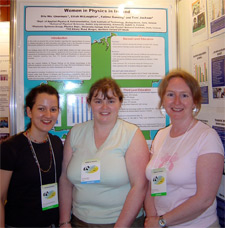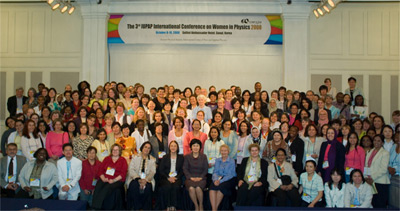History of the Conference
At the 1999 IUPAP General Assembly, the concern was raised that women are greatly under-represented in the field of physics in most countries. Recognizing that all fields of science progress most rapidly when they draw from the complete available pool of talented people, the participants of the General Assembly passed a resolution to form an IUPAP Working Group on Women in Physics.

The Working Group planned a three day International Conference on Women in Physics that was held at UNESCO Headquarters in Paris, France, from March 7 to 9, 2002. The results of this conference were presented at the IUPAP General Assembly in October 2002. The IUPAP International Conference on Women in Physics brought together more than 300 participants, about 15 percent of them men, from 65 countries to review data, discuss barriers, share success stories, propose ways to improve participation globally, develop resolutions for action by the IUPAP General Assembly, and help international teams develop appropriate strategies to improve the status of women in physics in their home countries.

Since 2005 is the International Year of Physics, the IUPAP working group together with Prof. Elisa Saitovitch, former president of the Brazilian Physical Society, decided to organize with the support of the IUPAP Working Group on Women in Physics a Second International Conference in Rio de Janeiro, Brazil. The main purpose of this conference was to analyze the international progress made in the 3 years since the first Conference and to learn about most successful strategies in bringing and keeping women in physics. Addition of a scientific session for sharing research among the Conference participants further stimulated interaction among the attendees, which opened new opportunities for development of international collaborations.

The Third International Conference took place in Seoul, Korea, in October 2008 with the intention of picking up where the previous Conference left off. The third Conference had a dual purpose:
- to provide an opportunity to share the scientific accomplishments of participants, and
- to analyze the international progress in promoting women in physics.
To achieve them six plenary talks were delivered by prominent women physicists, covering recent major achievements in each of the six areas of physics research. Other participants presented in the poster sessions that were divided into research posters and the work done in promoting women in physics. In addition to the plenary presentations and the poster sessions, several workshops were organized, including a lunchtime session where each delegate met with other delegates working in the same field.
Purpose of the Conference
The purpose of the Stellenbosch conference (ICWIP2011) is three-fold: (i) to provide an opportunity to view and analyze of the current status of and progress in promoting women in physics in each country and internationally; (ii) to provide an arena for women in physics to share their scientific accomplishments and create international scientific collaborations; and (iii) to build capacity in each participating country to design and implement changes that improve the participation and advancement of women in physics. By bringing together teams of physicists (mostly women) from across the globe, the Conference plans to:
- review the international status of women in physics country by country;
- share success stories and identify persistent barriers impeding women in physics;
- propose ways to improve women’s participation in physics worldwide;
- help teams refine and accelerate appropriate strategies to improve the status of women in physics in their home countries, regionally, and internationally;
- share physics research progress and results;
- seed collaborations in physics research, education, and outreach involving participants from multiple countries in related subdisciplines.
